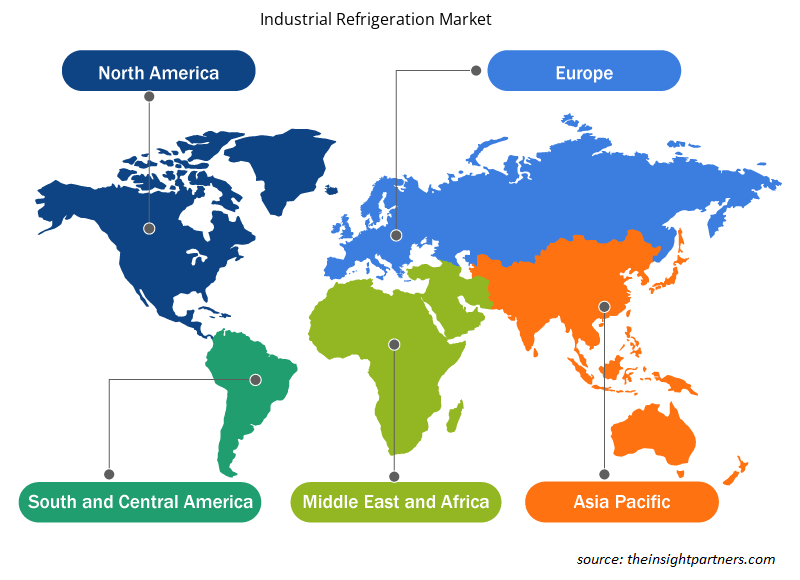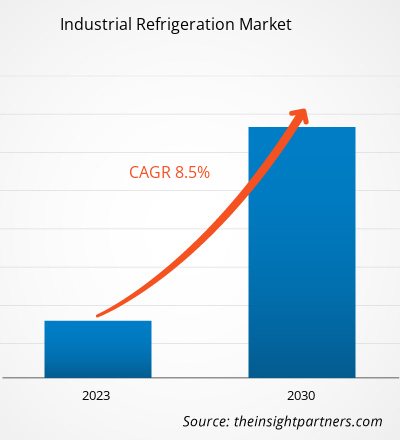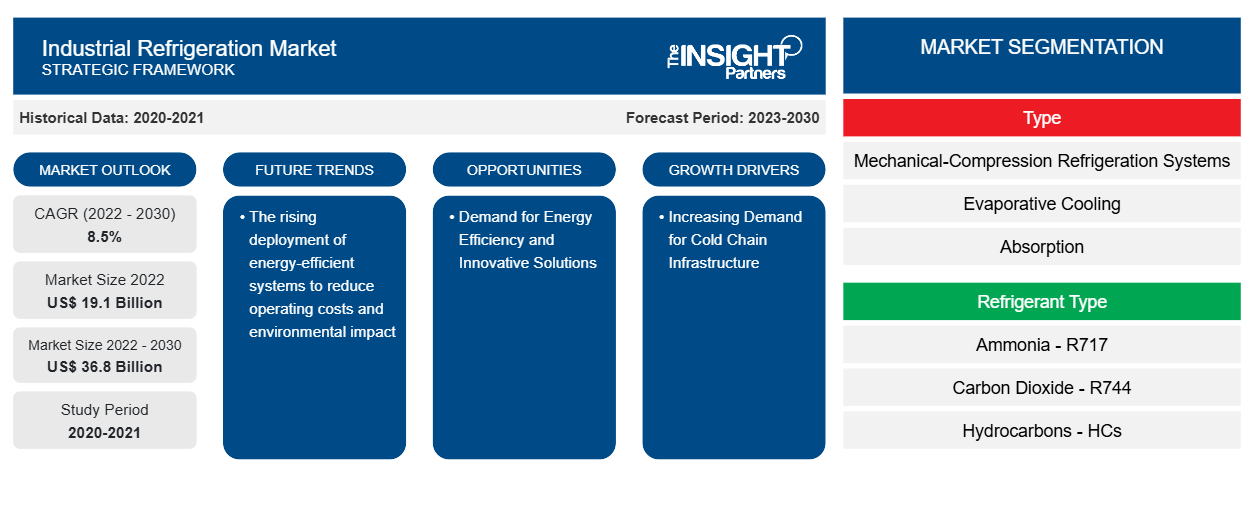工业制冷市场规模预计将从 2022 年的 191 亿美元增至 2030 年的 368 亿美元。预计 2022-2030 年期间,该市场的复合年增长率将达到 8.5%。为降低运营成本和环境影响而不断增加的节能系统部署可能仍将是市场的主要趋势。
工业制冷市场分析
工业制冷设备制造商专注于设计具有更高制冷效率的环保产品。严格的食品安全和质量法规推动了对可靠制冷解决方案的需求,从而导致物联网集成、先进控制系统和环保制冷剂的部署增加。此外,全球贸易和电子商务的兴起也扩大了对各种产品高效冷链运输的需求。因此,各行业越来越多地采用更环保的技术,例如环保的天然制冷剂,以符合可持续发展目标。
工业制冷市场概况
由于对冷藏、保鲜和运输易腐货物的需求不断增加,工业制冷设备市场稳步增长。工业制冷设备广泛应用于工业应用的各种产品,如化学加工、冷藏、食品和饮料,这些产品需要将材料保存在温控环境中。市场增长还归因于天然制冷剂的认可度不断提高、发达国家为提高能源效率而做出的努力不断增加以及加工食品行业的快速发展。此外,工业制冷设备在饮料生产、食品加工、工艺冷却和暖通空调应用中的使用量正在迅速增加。因此,食品饮料、制药和化学工业中应用数量的不断增长推动了全球工业制冷设备市场的发展。
定制此报告以满足您的需求
您可以免费定制任何报告,包括本报告的部分内容、国家级分析、Excel 数据包,以及为初创企业和大学提供优惠和折扣
- 获取此报告的关键市场趋势。这个免费样品将包括数据分析,从市场趋势到估计和预测。
工业制冷市场驱动因素和机遇
冷链基础设施需求增加利好市场
在线杂货和电子商务配送服务的扩张推动了对高效冷链物流的需求。Amazon Fresh 和 Instacart 等公司依靠冷藏仓库、送货车和最后一英里冷藏解决方案来确保产品以最佳状态交付给客户。因此,一些拥有冷链物流的公司正在提高其能力。例如,2022 年 12 月,印度阿萨姆邦一个容量为 5,000 公吨的冷藏设施开始运营。这个冷藏设施是该国东北地区最大的冷藏设施。这些设施大量需要各种制冷系统;因此,许多制冷市场公司已经为冷链行业推出了制冷产品。因此,由于易腐货物的国际贸易不断增加、食品行业的不断扩大以及消费者对新鲜产品的期望不断提高,对冷链基础设施的需求正在增长,这推动了工业制冷设备市场的增长。
对能源效率和创新解决方案的需求
为了追求可持续发展和节约成本,能源效率已成为使用制冷系统的企业的首要目标。现代制冷技术正在迅速发展以满足这些需求。压缩机是制冷系统的关键部件,正在得到显著改进,以提高效率并最大限度地减少能源消耗。
创新的制冷技术不仅能节约能源,还能提高整个制冷系统的性能和可靠性。随着各行各业努力优化能源使用并降低碳足迹,节能制冷方面的这些改进有望获得推动。
工业制冷市场报告细分分析
有助于得出工业制冷市场分析的关键部分是设置、运输和应用。
- 根据类型,工业制冷市场分为机械压缩制冷系统、蒸发冷却、吸收和热电。机械压缩制冷系统部分在 2022 年占据了更大的市场份额。
- 根据制冷剂类型,市场细分为氨 - R717、二氧化碳 (CO2) - R744 和碳氢化合物 - HC。氨-R717 部分在 2022 年占据了更大的市场份额。
- 根据应用,市场分为食品和饮料、制药、化工和石化、区域制冷、数据中心、电力生产等。食品和饮料部门在 2022 年占据了更大的市场份额。
工业制冷市场份额按地区分析
工业制冷市场报告的地理范围主要分为五个区域:北美、亚太、欧洲、中东和非洲、南美和中美。
北美工业制冷设备市场分为美国、加拿大和墨西哥。2022 年,美国占据了北美工业制冷设备市场的最大份额。在美国,各种工业冰箱制造商都在为 CO2 工业制冷系统开发产品和控制器技术。2022 年 1 月,美国制造商 Logix Controls 推出了专为工业 CO2 制冷系统设计的制冷系统控制器。Logix 控制器是与南非 CO2 制冷咨询公司 Future Green Now (FGN) 合作开发的。由于美国工业应用中 CO2 制冷系统的使用越来越多,Logix Controller 和 Future Green Now (FGN) 专注于开发工业制冷控制器。新的 CO2 系统控制器最大限度地降低了大型工业 CO2 系统运行的能耗,并确保了最安全的运行。
工业制冷市场区域洞察
Insight Partners 的分析师已详细解释了预测期内影响工业制冷市场的区域趋势和因素。本节还讨论了北美、欧洲、亚太地区、中东和非洲以及南美和中美洲的工业制冷市场细分和地理位置。

- 获取工业制冷市场的区域具体数据
工业制冷市场报告范围
| 报告属性 | 细节 |
|---|---|
| 2022 年市场规模 | 191亿美元 |
| 2030 年市场规模 | 368亿美元 |
| 全球复合年增长率(2022 - 2030 年) | 8.5% |
| 史料 | 2020-2021 |
| 预测期 | 2023-2030 |
| 涵盖的领域 | 按类型
|
| 覆盖地区和国家 | 北美
|
| 市场领导者和主要公司简介 |
|
工业制冷市场参与者密度:了解其对业务动态的影响
工业制冷市场正在快速增长,这得益于终端用户需求的不断增长,而这些需求又源于消费者偏好的不断变化、技术进步以及对产品优势的认识不断提高等因素。随着需求的增加,企业正在扩大其产品范围,进行创新以满足消费者的需求,并利用新兴趋势,从而进一步推动市场增长。
市场参与者密度是指在特定市场或行业内运营的企业或公司的分布情况。它表明在给定市场空间中,相对于其规模或总市场价值,有多少竞争对手(市场参与者)存在。
在工业制冷市场运营的主要公司有:
- 萨米菲法国有限公司
- 江森自控国际有限公司
- 让·波米耶父子
- 丹佛斯公司
- 载体
- 霍尼韦尔国际公司
免责声明:上面列出的公司没有按照任何特定顺序排列。

- 了解工业制冷市场主要参与者概况
工业制冷市场新闻和最新发展
工业制冷市场通过收集一手和二手研究后的定性和定量数据进行评估,其中包括重要的公司出版物、协会数据和数据库。工业制冷市场的一些发展情况如下:
- 霍尼韦尔国际公司宣布,中国医药集团有限公司(国药集团)子公司国药上海生物医药有限公司已采用霍尼韦尔 Solstice N40(R-448A)制冷剂。该节能、低全球变暖潜能值 (GWP) 解决方案将用于冷藏上海使用的国药集团疫苗,包括该公司的 COVID-19 疫苗。(来源:霍尼韦尔国际公司,公司网站,2022 年 4 月)
- Evapco Inc. 收购了加拿大二氧化碳制冷系统制造商 Systèmes LMP。Evapco 希望通过此次战略联盟支持其努力满足市场对使用天然制冷剂的环保可持续制冷系统日益增长的需求。此次收购通过扩展到 LMP 的二氧化碳专业知识和产品供应,增强了其主要基于氨的工业技术产品。(来源:Evapco Inc.,公司网站,2022 年 2 月)
工业制冷市场报告范围和交付成果
“工业制冷市场规模和预测(2020-2030 年)”报告对以下领域进行了详细的市场分析:
- 工业制冷市场规模及全球、区域和国家层面所有主要细分市场的预测
- 工业制冷市场趋势以及市场动态,如驱动因素、限制因素和关键机遇
- 详细的 PEST/波特五力分析和 SWOT 分析
- 工业制冷市场分析涵盖主要市场趋势、全球和区域框架、主要参与者、法规和最新市场发展
- 行业格局和竞争分析,涵盖市场集中度、热图分析、知名参与者以及工业制冷市场的最新发展
- 详细的公司简介
- 历史分析(2 年)、基准年、预测(7 年)及复合年增长率
- PEST和SWOT分析
- 市场规模、价值/数量 - 全球、区域、国家
- 行业和竞争格局
- Excel 数据集
近期报告
客户评价
购买理由
- 明智的决策
- 了解市场动态
- 竞争分析
- 客户洞察
- 市场预测
- 风险规避
- 战略规划
- 投资论证
- 识别新兴市场
- 优化营销策略
- 提升运营效率
- 顺应监管趋势





















 获取免费样品 - 工业制冷市场
获取免费样品 - 工业制冷市场